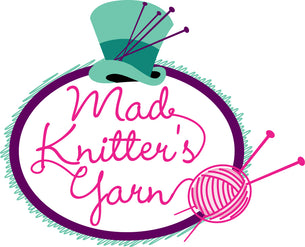A Labor of Love
Posted by Sami Buckley on

March is a month where, while the weather may still be chilly, our hearts all start to warm up as we eat our way through boxes of chocolate and craft something special for the loved ones in our lives. We run our fingertips along the soft, springy, and decadent yarns, contemplating these projects and wonder how many yards we’ll need. Whether you’re rifling though cottons, wools, acrylics, etc., I thought you might want to know a bit more about all of those hanks, cakes, and balls spinning around in your crafty daydreams. After seeing all of the beautiful colors our resident hand-dyer Will Spargur, of Spargur Yarn Co. (www.sparguryarn.com, @sparguryarnco on Instagram) launched at his trunk show, I thought it might be fun to go over the hand-dying process.
Gadgets and Necessities
I don’t know about you, but I LOVE gadgets. I love my cute little steeking scissors, tape measures, markers, yarn bowls, keychain crochet hook, counters, etc. etc. If there’s a gadget, chances are that I’m dying to add it to my collection. Marie Kondo couldn’t stop me even if she tried; they all bring me joy, even the ones I haven’t used (yet!). So when I hear about a hobby with a toolset? That’s the kind of hobby I like to get behind.
This post (https://www.fiberartsy.com/beginner-guide-to-hand-dyeing-yarn/) went over the entire process and the tools to get you started, so I’ll summarize what Annette went over for you.

Spargur Yarn Co.
Here’s a list of the basic dying supplies that you’ll need:
-Old pots, roasting pans, glass casserole dishes
-Gloves
-Plastic cups, spoons (for mixing dye powder)
-Face mask
-Chop sticks (handy for moving yarn around gently)
-White vinegar (for acid dyes)
-Plastic wrap
-Squirt bottles or small cups
-Heat source: stove or hot plate
Next, the two most important items: wool and dye. Annette states that you can use just about any fiber, but that you’ll have to alter which dye you use based on that choice. She uses Jacquard Acid Dyes for animal fibers, and Jacquard iDyes for plant fibers.

How Dyers Go About It
There are a bunch of ways to go about dying yarn, and Annette goes over six different ways on her blog post : Solid, Semi-Solid or Tonal, Gradated or Ombre, Variegated or Multi-Color, Speckled or Sprinkle Dyed, Self Striping Yarn. For simplicity’s sake, I’ll just go over an easy, one-color Knit Picks tutorial for Jacquard Dyes.
1.) Take a bare skein of yarn and thoroughly soak it in water. Squeeze out any and all air bubbles, which can block dye from sticking to the yarn.
2.) Bring a full pot of water to simmer, and then add in the dye and white vinegar. Knit Picks gives the ratio: “1 tsp dye powder and 3 tbsp of white vinegar for every 100 grams of yarn.” Stir this mixture together until well-combined.
3.) Place soaking yarn into pot and stir to make sure dye fully covers yarn surfaces.
4. ) Let simmer in dye for 30 minutes or until water is clear. If you occasionally stir, you’re more likely to get a uniform color. If you leave to sit, there might be some color gradation. (Personally, I’m a huge fan of color gradation because I feel like it gives the project more depth when you’re working with a single color.)
5.) Remove from pot and hang to dry, preferably outside if possible.
To Dye or Not to Dye
Now that you know what you need and what to do, are you ready to start making your own color-ways? I don’t know if I am. I mean, I can certainly picture myself standing like a crafty witch, stained with wayward dye and stirring my big dye pot like I’m making a love potion after a particularly disappointing Valentine’s Day. That’s an aesthetic I could get behind; a vibe I could see myself rocking. Am I ready to put all the time and cash down for fiber and dye to start this new hobby? Not just yet, although I definitely see it on the horizon.

Spargur Yarn Co.
I did, however, gain a new perspective and appreciation for all of the hand-dyers out there, creating beautiful, craft-able art for us to work with; also, for saving our aprons and cookware for a little while longer. I found that, for me, the light wasn’t at the end of the tunnel, but at the bottom of my shopping bag. Being able to make your own color ways is a great way to personalize your craft even more, but if you’re not ready to start brewing up a new yarn stash then you can always support the hand-dyers in your area. Reinvesting in the crafts we love, the stores that sell them, and the artisans that make these hand dyes so special is a great way to make that project you’ve been considering a little more special and help support our close-“knit” community.
